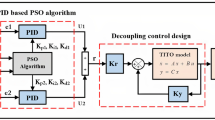Abstract
In this paper, a method of designing control inputs for stochastic nonlinear processes under state-feedback is proposed. The objective is to determine a control input that minimizes the expected value of the integral of error between the set-point and the states. Since the states may not be measured, they are estimated using a particle filtering algorithm. The optimal control design is then reformulated as a parameter estimation problem using control vector parameterization where the inputs are considered as a nonlinear function of the error between the state estimates and the set-point. The parameters are then computed through a homotopy based optimization method. The control performance resulting from proposed homotopy based optimization method is compared with that of direct optimization and an existing nonlinear control method on a Solid Oxide Fuel Cell (SOFC) stack model.













Similar content being viewed by others
References
Crisan D (2001) Particle filters—a theoretical perspective. In: Doucet A, de Freitas N, Gordon N (eds) Chap. 2: Sequential Monte Carlo methods in practice, vol 45. Springer, Berlin, pp 17–41
Øksendal B (2003) Stochastic differential equations—an introduction with applications. Springer, Berlin
Pham H (2005) On some recent aspects of stochastic control and their applications. Probab Surv 2:506–549
Mesbah A (2016) Stochastic model predictive control: An overview and perspectives for future research. IEEE Control Syst Mag 36(6):30–44
Heirung TAN, Paulson JA, O’Leary J, Mesbah A (2018) Stochastic model predictive control—how does it work? Comput Chem Eng 114:158–170
Mesbah A, Streif S, Findeisen Braatz RD (2014) Stochastic nonlinear model predictive control with probabilistic constraints. IEEE Proceedings 2014 American control conference, pp 2413–2419
Sehr MA, Bitmead RR (2018) Stochastic output-feedback model predictive control. Automatica 94:315–323
Bradford E, Imsland L (2019) Output feedback stochastic nonlinear model predictive control for batch processes. Comput Chem Eng 126:434–450
Sehr MA, Bitmead RR (2017) Particle model predictive control: tractable stochastic nonlinear output-feedback mpc. IFAC-PapersOnLine 50(1), 15361–15366 . 20th IFAC world congress
Pan B, Lu P, Pan X, Ma Y (2016) Double-homotopy method for solving optimal control problems. J Guid Control Dyn 39(8):1706–1720
Biegler LT (2010) Nonlinear programming: concepts, algorithms, and applications to chemical processes. Society for Industrial and Applied Mathematics, University City
Schlegel M, Stockmann K, Binder T, Marquardt W (2005) Dynamic optimization using adaptive control vector parameterization. Comput Chem Eng 29(8):731–1751
Kraft D (1985) On converting optimal control problems into nonlinear programming problems. In: Schittkowski K (ed) Comput Math Program. Springer, Berlin, pp 261–280
Binder T, Cruse A, Villar CC, Marquardt W (2000) Dynamic optimization using a wavelet based adaptive control vector parameterization strategy. Comput Chem Eng 24(2):1201–1207
Bock HG, Plitt KJ (1984) A multiple shooting algorithm for direct solution of optimal control problems. IFAC Proceedings 17(2):1603–1608 . 9th IFAC world congress
Cuthrell JE, Biegler LT (1987) On the optimization of differential-algebraic process systems. AIChE J 33(8):1257–1270
Dunlavy DM, O’leary DP, Klimov D, Thirumalai, D, (2005) Hope: a homotopy optimization method for protein structure prediction. J Comput Biol 12(10):1275–1288
Vyasarayani CP, Uchida T, Carvalho A, McPhee J (2011) Parameter identification in dynamic systems using the homotopy optimization approach. Multibody Syst Dyn 26(4):411–424
Varanasi SK, Jampana P, Vyasarayani CP (2021) Minimum attention stochastic control with homotopy optimization. Int J Dyn Control 9(1):266–274
Zhao Z, Huang B, Liu F (2012) A particle filter based on a constrained sampling method for state estimation. In: 15th international conference on information fusion, pp 816–823
Watson LT, Haftka RT (1989) Modern homotopy methods in optimization. Comput Methods Appl Mech Eng 74:295–305
Padulles J, Ault G, McDonald J (2000) An integrated SOFC plant dynamic model for power systems simulation. J Power Sources 86(1):495–500
Murshed AM, Huang B, Nandakumar K (2007) Control relevant modeling of planer solid oxide fuel cell system. J Power Sources 163(2):830–845
Rambabu K, Lars I, Bjarne A, Christoph S, Bjorn T, Olav B (2007) Modeling and control of a SOFC-GT based autonomous power system. Energy 32(4):406–417
Fleming EM, Hiskens IA (2007) Dynamics of a microgrid supplied by solid oxide fuel cells. In: Bulk power system dynamics and control-VII. Revitalizing operational reliability, 2007 iREP Symposium. IEEE, pp 1–10
Kandukuri KR, Polisetty VG, Jampana P (2020) Modeling and control study of solid oxide fuel cell at low operating pressures. IFAC-PapersOnLine 53(1), 289–294. 6th conference on advances in control and optimization of dynamical systems
Arulampalam MS, Maskell S, Gordon N, Clapp T (2002) A tutorial on particle filters for online nonlinear/non-Gaussian Bayesian tracking. IEEE Trans Signal Process 50(2):174–188
Kloeden PE, Platen E (2011) Numerical solution of stochastic differential equations. Springer, Berlin
Hoskins J, Himmelblau D (1988) Artificial neural network models of knowledge representation in chemical engineering. Comput Chem Eng 12(9):881–890
Funding
No funding agency for the research work carried out in this article.
Author information
Authors and Affiliations
Contributions
First Author (Mr. Venkata Goutham Polisetty) has written most of the paper, carried out most of the research work, obtained all the simulation results, their presentation and analysis. He has also written detailed responses to the reviewers with the required simulations. Second Author (Dr. Santhosh Kumar Varanasi) has assisted the First Author in the simulation work, has written some parts of the paper and also contributed to the development of part of the theory (i.e., sigmoid basis). Corresponding author (Dr. Phanindra Jampana) has provided the overall inputs for the theoretical development of the filtering and the control algorithms. He also oversaw the revision process and the preparation of the reviewer comments.
Corresponding author
Ethics declarations
Conflict of interest
The authors have no competing interests to declare.
Availability of data and materials
Available upon request from authors.
Code availability
Available upon request from authors.
Rights and permissions
About this article
Cite this article
Polisetty, V.G., Varanasi, S.K. & Jampana, P. Stochastic state-feedback control using homotopy optimization and particle filtering. Int. J. Dynam. Control 10, 942–955 (2022). https://doi.org/10.1007/s40435-021-00853-w
Received:
Revised:
Accepted:
Published:
Issue Date:
DOI: https://doi.org/10.1007/s40435-021-00853-w




